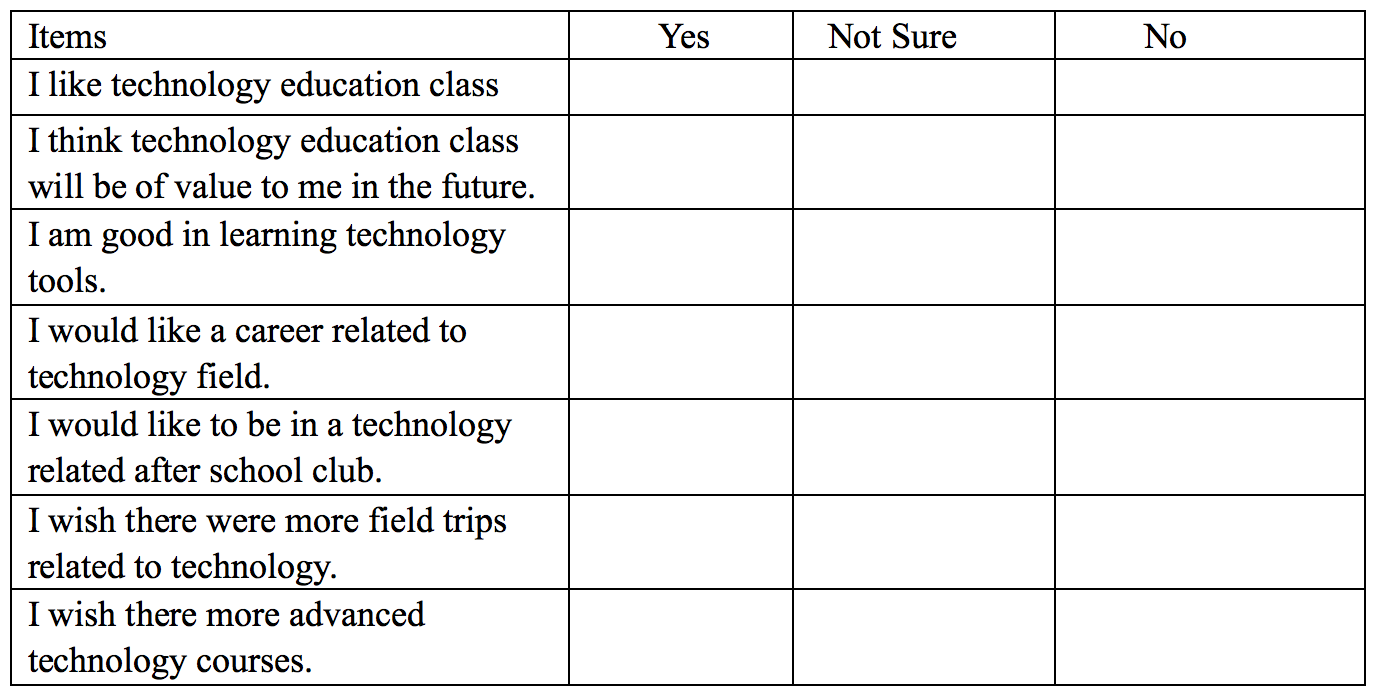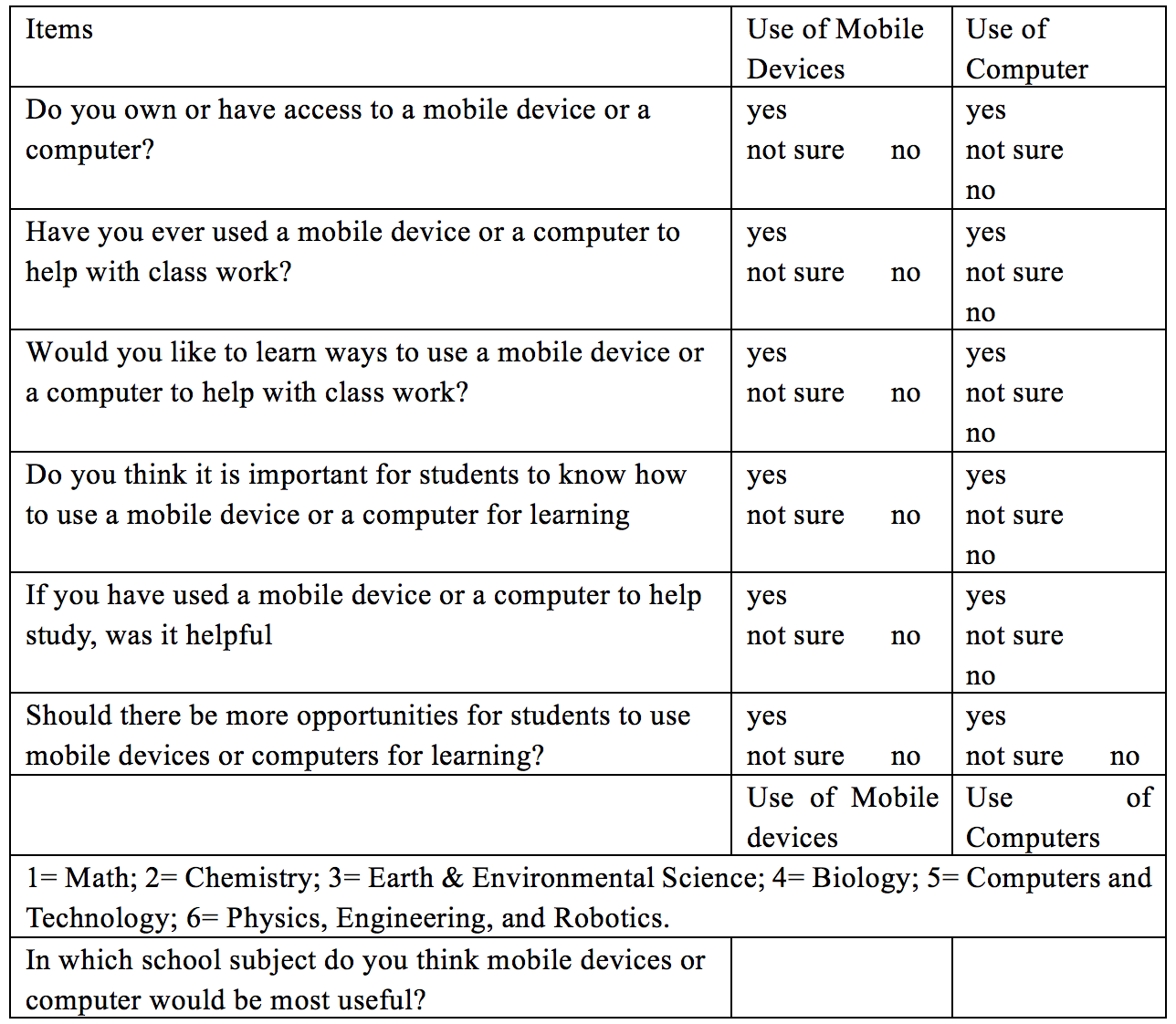Utilizing Technology for Learning STEM Subjects: Perceptions of Urban African-American Middle School Students
By
2016, Vol. 8 No. 02 | pg. 3/3 | « Implications for Learning and TeachingThe compelling question to ask is how to exploit the potential of technology to promote students’ engagement, thereby enhance students’ academic achievement in Science, Computing, Engineering, Mathematics and other so-called technical disciplines (STEM), particularly for African American population. To that end, we provide some recommendations to educational practitioners (e.g., teachers, administrators):
Recommendations for Future ResearchThis research provides evidences of African-American students’ attitudes toward technology education and preferences with regard to the use of technology for STEM learning across gender and grade. However, the result of the current study is not sufficient to be representative for this population. Future research should gain more insight through a larger sample size. In addition, future research should seek to explore why African-American boys are more willing to use a computer to help study than African-American girls, or why African-American girls are more likely to think it is helpful to use a computer to help their study. Why do younger African American children have stronger tendency to do class work through computers and believe that it is beneficial when using computers to help study? Why do African-American students think mobile devices are useful for learning mathematics? These questions will ultimately need to be answered in future research.Through understanding the perceptions of today’s African American middle school students about technology education and the use of technology for learning, future research should address ways in which the African-American students’ positive attitudes and motivation can be exploited to promote success in STEM related fields. ConclusionsThe potential of technology to enhance pedagogical practices in K-12 STEM education requires an understanding of the preferences, attitudes, and technological habits of students. While there has been some research in this area, there has been limited focus on minority students, especially those in high poverty, urban settings. Although it is widely recognized that increasing effective STEM engagement for this segment of the population is an important requirement for the country’s future, there is little information on their views and habits with regard to technology and its relevance to STEM education. This study sought to provide insights into this area at a critical point of potential intervention, middle level education. The results of the study indicated that respondents to the survey were positive about the potential of technology in their education. Most did not indicate any significant limitations with regard to technology access. Remarkably, the respondents favorably valued the importance of technology and its significance in terms of STEM learning. Most, for example, perceived that it was important to know how to use the technology tools and looked forward to more opportunities to use technology tools for learning, therefore, more than half of them favored additional advanced courses related to technology and there was considerable demand for technology-focused after-school experiences. Few notable differences were noted between males and females. In the third section of the survey, comparing to African-American girls, African-American boys expressed greater interests in doing class work with assistance of technology devices; however, African-American girls were more likely to value the meaningfulness of the use of technology for learning, particular when the role of technology is to help study. The overall conclusion for this study was that African-American students were more positive toward technology than some literature (Fairlie, 2012; Jackson et al., 2008; MacHale, 2007) would suggest. It suggested that teachers and administrators should become familiar with the various ways minority students’ technology interests were supported in the school and at home and disseminate information about informal technology related activities or programs. Additionally, the preferences and perceptions of these students were relevant to the design of technology-based learning experiences. For example, if African-American students perceived that mobile devices were useful for learning mathematics, then this is a potential area that educators can exploit to promote practice and engage the learner.
ReferencesCheung, A. C. K., & Slavin, R. E. (2013). The effectiveness of educational technology applications for enhancing mathematics achievement in K-12 classrooms: A meta-analysis. Educational Research Review, 9, 88-113. doi:10.1016/j.edurev.2013.01.001 Clark-Wilson, A.; Hoyles, C.; Noss, R.; Vahey, P.; Roschelle, J. (2015). Scaling a technology-based innovation: windows on the evolution of mathematics teachers’ practices. The International Journal on Mathematics Education, 47 (1), 79-92. doi:10.1007/s11858-014-0635-6 Else-Quest, N. M., Mineo, C. C., & Higgins, A. (2013). Math and science attitudes and achievement at the intersection of gender and ethnicity. Psychology of Women Quarterly, 37(2). doi:10.1177/0361684313480694. Eschenbrenner, B., & Nah, F. H. F. (2007). Mobile technology in education: uses and benefits. International Journal of Mobile Learning and Organization, 1(2), 159-183. doi:10.1504/IJMLO.2007.012676 Farinde, A. A. & Lewis, C. W. (2012). The underrepresentation of African American female students in STEM fields: Implications for classroom teachers. US-China Education Review B 4, 421-430. Retrieved from: http://www.eric.ed.gov/contentdelivery/servlet/ERICServlet?accno=ED533550 Fairlie, R. W. (2012). Academic achievement, technology and race: Experimental evidence. Economics of Education Review, 31(5), 663-679. doi:10.1016/j.econedurev.2012.04.003 Grant, M. M. & Barbour, M. K. (2013). "Mobile Teaching and Learning in the Classroom and Online: Case Studies in K-12." Handbook of Mobile Learning. Berge, Z. & L. Muilenburg, eds. New York: Routledge. George, D., & Mallery, P. (2003). SPSS for Windows step by step: A simple guide and reference. 11.0 update (4th ed.). Boston: Allyn & Bacon Gibbons, J. D. (1993). Non-parametric statistics: an introduction. Newbury Park, CA: Sage Publications. Griffith, A. L. (2010). Persistence of women and minorities in STEM field majors: Is it the school that matters? Economics of Education Review 29, 911–922. doi: 10.1016/j.econedurev.2010.06.010 Goldstein, J., & Puntambekar, S. (2004). The brink of change: Gender in technology-rich collaborative learning environments. Journal of Science Education and Technology, 13(4), 506-522. doi:10.1007/s10956-004-1471-1 Hesseldahl, A. (2008). Bringing broadband to the urban poor. Bloomberg Business Week. Retrieved from: http://www.businessweek.com/technology/content/dec2008/tc20081230_015542.htm Hmelo-Silver, C. E., Eberbach, C., & Jordan, R. (2014). Technology-Supported Inquiry for Learning about Aquatic Ecosystems. EURASIA Journal of Mathematics, Science & Technology Education, 10(5), 405-413. doi: 10.12973/eurasia.2014.1170a Hossain, M. M., & Robinson, M.G. (2012). How to motivate US students to pursue STEM (Science, Technology, Engineering and Mathematics) careers. US-China Education Review A 4, 442-451. Retrieved from: http://files.eric.ed.gov/fulltext/ED533548.pdf Jackson, L. A., Zhao, Y., Kolenic, A., Fitzgerald, H. E., Harold, R., & Von-Eye, A. (2008). Race, gender, and information technology use: The new digital divide. Cyber Psychology and Behavior, 11(4), 437–442. doi:10.1089/cpb.2007.0157 KAHVECI, M. (2010). Students’ perceptions to use technology for learning: Measurement integrity of the modified Fennma-Sherman attitude scales. The Turkish Online Journal of Educational Technology, 9(1), 185-201. Retrieved from: http://eric.ed.gov/?id=EJ875782 Lane, A. (2014, December 20). More than 1 in 4 school-aged children in Louisiana live in poverty. The Times-Picayune. Retrieved from: http://www.nola.com/news/baton-rouge/index.ssf/2014/12/poverty_education_louisiana_ce.html Louisiana STEM Expo. (2014). Former astronaut to highlight Louisiana STEM Expo. Retrieved from: http://www.kenilworthst.org/press/10-09-2013-Former%20astronaut%20to%20highlight%20Louisiana%20STEM%20Expo.pdf Mahoney, M. P. (2010). Students’ attitudes toward STEM: development of an instrument for high school STEM-based programs. The Journal of Technology Studies, 36(1), 24-34. Retrieved From: http://scholar.lib.vt.edu/ejournals/JOTS/v36/v36n1/mahoney.html McHale, T. (2007). One-to-one in Texas: Part three of our series on one-to-one programs. Technology & Learning, 27(6), p22. Retrieved from: http://www.techlearning.com/section/MagazineArchive. McNierney, D. J. (2004). One teacher's odyssey through resistance and fear. TechTrends: Linking Research & Practice to Improve Learning, 48(5), 66-71. doi: 10.1007/bf02763533 Mitts, C. R., & Haynie, W. J. (2010). Preferences of male and female students for TSA competitive events. Technology and Engineering Teacher, 70(1), 19-26. Retrieved from: http://eric.ed.gov/?id=EJ898908 Mouze, C. (2008). Learning with laptops: Implementation and outcomes in an urban, under-privileged school. Journal of Research on Technology in Education, 40(4), 447-472. doi: 10.1080/15391523.2008.10782516 Ong, M. (2011). The status of women of color in computer science. Communications of the ACM, 54(7), 32-34. doi: 10.1145/1965724.1965737 Oravetz, C. L. (2011). Assessing middle school student participation in online vs. face-to-face environments. Retrieved from ProQuest LLC, Ed.D. Dissertation, Northeastern University. Plumm, K. M. (2006). Technology in the classroom: Burning the bridges to the gaps in gender-biased education? Computers & Education, 50, 1052-1068. doi: 10.1016/j.compedu.2006.10.005 Project Tomorrow. (2013). Making learning mobile 1.0: Leveraging mobile devices to transform teaching and learning in 8th grade classes at Stone middle school. Retrieved from: http://www.tomorrow.org/publications/MobileDevicesTransformTeaching.html Ritzhaupt, A. D., Liu, F., Dawson, K., & Barron, A. E. (2013). Differences in student information and communication technology literacy based on socio-economic status, ethnicity, and gender. Journal of Research on Technology in Education, 45(4), 291–307. doi:10.1080/15391523.2013.10782607 Royston, P. (1982). An extension of Shapiro and Wilk's W test for normality to large samples. Journal of the Royal Statistical Society. Series C (Applied Statistics), 31(2), 115–124. doi: 10.2307/2347973 Sessoms, D. (2008). Interactive instruction: Creating interactive learning environments through tomorrow’s teachers. International Journal of Technology in Teaching and Learning, 4(2), 86-96. Taines, C., Schneider, R., & Blumenfeld, P. C. (2000). Observations of urban middle school students engaged in technology-supported inquiry. Paper presented at the Annual Meeting of the American Educational Research Association, New Orleans, LA. U.S. Department of Education. (2003). Federal funding for educational technology and how it is used in the classroom: A summary of findings from the integrated studies of educational technology. Washington, DC: U.S. ED Pubs. Editorial Publications Center.
AppendixSurvey of Students’ Interests in TechnologyInstructions: This survey presents a series of questions about your interest in technology education and the use of technology for learning. There are no right or wrong answers to any item on this survey, we want you to express your personal interests or feelings. For each item, please check the answer that best reflects your interests or feelings. About You
Students’ Interests in Technology EducationThe Use of Technology in Learning
Suggested Reading from Inquiries Journal
Inquiries Journal provides undergraduate and graduate students around the world a platform for the wide dissemination of academic work over a range of core disciplines. Representing the work of students from hundreds of institutions around the globe, Inquiries Journal's large database of academic articles is completely free. Learn more | Blog | Submit Latest in Education |






















